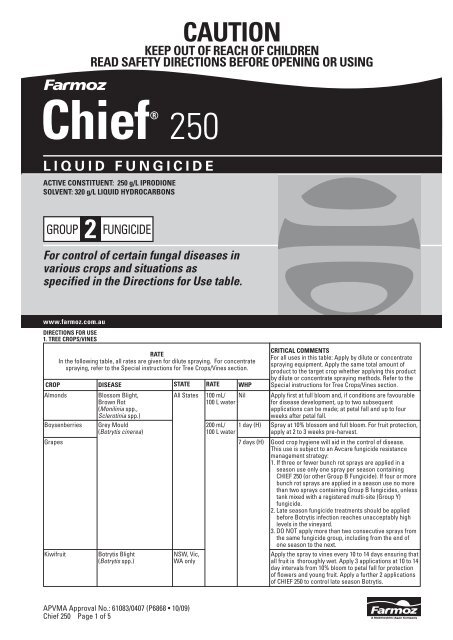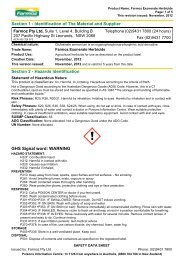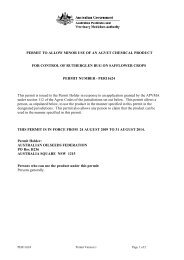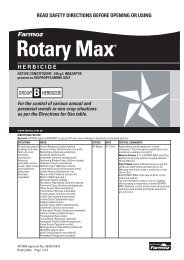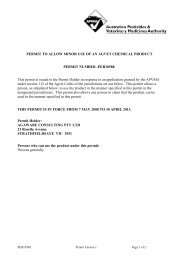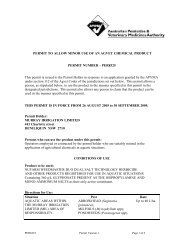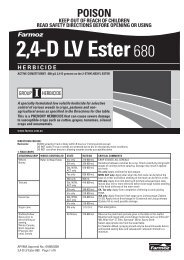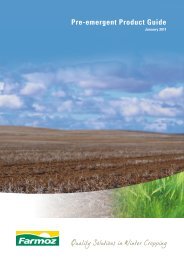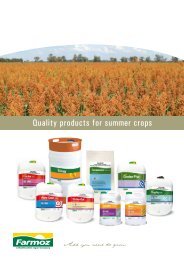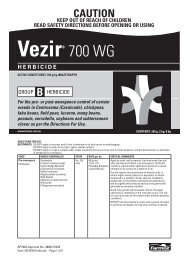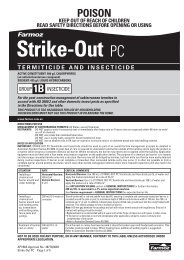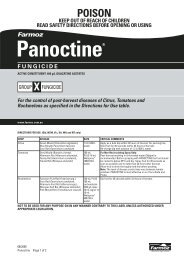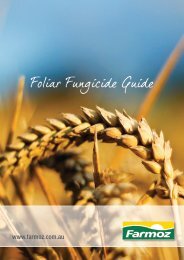Chief 250 pmanual - Farmoz
Chief 250 pmanual - Farmoz
Chief 250 pmanual - Farmoz
You also want an ePaper? Increase the reach of your titles
YUMPU automatically turns print PDFs into web optimized ePapers that Google loves.
For control of certain fungal diseases in<br />
various crops and situations as<br />
specified in the Directions for Use table.<br />
www.farmoz.com.au<br />
DIRECTIONS FOR USE<br />
1. TREE CROPS/VINES<br />
CAUTION<br />
KEEP OUT OF REACH OF CHILDREN<br />
READ SAFETY DIRECTIONS BEFORE OPENING OR USING<br />
<strong>Chief</strong>®<br />
ACTIVE CONSTITUENT: <strong>250</strong> g/L IPRODIONE<br />
SOLVENT: 320 g/L LIQUID HYDROCARBONS<br />
GROUP 2 FUNGICIDE<br />
RATE<br />
In the following table, all rates are given for dilute spraying. For concentrate<br />
spraying, refer to the Special instructions for Tree Crops/Vines section.<br />
CROP DISEASE STATE RATE WHP<br />
Almonds Blossom Blight,<br />
Brown Rot<br />
(Monilinia spp.,<br />
Sclerotinia spp.)<br />
Boysenberries Grey Mould<br />
(Botrytis cinerea)<br />
APVMA Approval No.: 61083/0407 (P6868 • 10/09)<br />
<strong>Chief</strong> <strong>250</strong> Page 1 of 5<br />
<strong>250</strong><br />
LIQUID FUNGICIDE<br />
Kiwifruit Botrytis Blight<br />
(Botrytis spp.)<br />
All States 100 mL/<br />
100 L water<br />
NSW, Vic,<br />
WA only<br />
200 mL/<br />
100 L water<br />
Nil<br />
1 day (H)<br />
CRITICAL COMMENTS<br />
For all uses in this table: Apply by dilute or concentrate<br />
spraying equipment. Apply the same total amount of<br />
product to the target crop whether applying this product<br />
by dilute or concentrate spraying methods. Refer to the<br />
Special instructions for Tree Crops/Vines section.<br />
Apply first at full bloom and, if conditions are favourable<br />
for disease development, up to two subsequent<br />
applications can be made; at petal fall and up to four<br />
weeks after petal fall.<br />
Spray at 10% blossom and full bloom. For fruit protection,<br />
apply at 2 to 3 weeks pre-harvest.<br />
Grapes 7 days (H)<br />
Good crop hygiene will aid in the control of disease.<br />
This use is subject to an Avcare fungicide resistance<br />
management strategy:<br />
1. If three or fewer bunch rot sprays are applied in a<br />
season use only one spray per season containing<br />
CHIEF <strong>250</strong> (or other Group B Fungicide). If four or more<br />
bunch rot sprays are applied in a season use no more<br />
than two sprays containing Group B fungicides, unless<br />
tank mixed with a registered multi-site (Group Y)<br />
fungicide.<br />
2. Late season fungicide treatments should be applied<br />
before Botrytis infection reaches unacceptably high<br />
levels in the vineyard.<br />
3. DO NOT apply more than two consecutive sprays from<br />
the same fungicide group, including from the end of<br />
one season to the next.<br />
Apply the spray to vines every 10 to 14 days ensuring that<br />
all fruit is thoroughly wet. Apply 3 applications at 10 to 14<br />
day intervals from 10% bloom to petal fall for protection<br />
of flowers and young fruit. Apply a further 2 applications<br />
of CHIEF <strong>250</strong> to control late season Botrytis.
1. TREE CROPS/VINES – continued<br />
CROP DISEASE STATE RATE WHP CRITICAL COMMENTS<br />
Macadamias Botrytis Blight<br />
(Botrytis spp.)<br />
Mandarins<br />
(non-bearing)<br />
Passionfruit Alternata Spot<br />
(Brown Spot)<br />
(Alternaria spp.,<br />
Alternaria passiflorae)<br />
Stone Fruit:<br />
Apricots,<br />
cherries,<br />
nectarines,<br />
peaches,<br />
plums<br />
<strong>Chief</strong> <strong>250</strong> Page 2 of 5<br />
Alternaria Leaf Spot<br />
(Brown Spot)<br />
(Alternaria alternata)<br />
Raspberries Grey Mould<br />
(Botrytis cinerea)<br />
Orchard Spraying<br />
Blossom Blight<br />
(Monilinia fructicola,<br />
Monilinia laxa),<br />
Brown Rot<br />
(Monilinia fructicola,<br />
Monilinia laxa)<br />
Youngberries Grey Mould<br />
(Botrytis cinerea)<br />
All States 100 mL/<br />
100 L water<br />
Qld, WA,<br />
NT only<br />
Qld, NSW,<br />
WA,<br />
NT only<br />
Qld,NSW,<br />
Vic, Tas,<br />
SA, WA<br />
only<br />
200 mL/<br />
100 L water<br />
200 mL/<br />
100 L water<br />
100 to 150<br />
mL/100 L<br />
water<br />
All States 200 mL/<br />
100 L water<br />
Nil<br />
7 days (H)<br />
Nil<br />
1 day (H)<br />
Apply as a thorough cover spray to flower racemes when<br />
they open. A follow up spray may be needed one week<br />
later if wet conditions persist during flowering. Remove<br />
nuts under trees prior to spraying.<br />
Apply to non-bearing trees of Murcott variety monthly<br />
from first flush in Spring until flushing ceases in the<br />
Autumn. Reduce intervals to fortnightly during periods of<br />
wet weather.<br />
This use is subject to an Avcare fungicide resistance<br />
management strategy:<br />
1. Maintain a protective cover with protectant fungicide<br />
such as mancozeb.<br />
2. Limit the use of CHIEF <strong>250</strong> to strategic periods, i.e.<br />
before, during and after extended wet periods.<br />
3. Always tank mix CHIEF <strong>250</strong> with a protectant such<br />
as mancozeb.<br />
4. DO NOT apply more than four CHIEF <strong>250</strong> (or other<br />
Group B fungicide) sprays in a season.<br />
All States 1 day (H) Spray at 10% blossom and full bloom. For fruit protection,<br />
2. BERRIES: (See Tree Crops/Vines for boysenberries, raspberries and youngberries.)<br />
CROP DISEASE STATE RATE WHP CRITICAL COMMENTS<br />
Strawberries Grey Mould<br />
(Botrytis cinerea)<br />
Celery Sclerotinia Rot (Pink Rot)<br />
(Sclerotinia sclerotiorum)<br />
Lettuce Sclerotinia Rot (drop)<br />
(Sclerotinia sclerotiorum,<br />
Sclerotinia minor)<br />
All States 2.0 L/ha<br />
where<br />
spray<br />
volume is<br />
less than<br />
1000 L/ha<br />
OR 200 mL/<br />
100 L water<br />
where<br />
spray<br />
volume<br />
equals or<br />
exceeds<br />
1000 L/ha<br />
1 day (H)<br />
3. VEGETABLES<br />
CROP DISEASE STATE RATE WHP CRITICAL COMMENTS<br />
Grey Mould (Botrytis spp.) Tas,<br />
WA only<br />
All States 2.0 L/ha<br />
where<br />
spray<br />
volume is<br />
less than<br />
1000 L/ha<br />
OR 200 mL/<br />
100 L water<br />
where<br />
spray<br />
volume<br />
equals or<br />
exceeds<br />
1000 L/ha<br />
1 day (H)<br />
7 days (H)<br />
apply at 2 to 3 weeks pre-harvest.<br />
For control of Blossom Blight, spray at 10% blossom, full<br />
bloom and petal/shuck fall. For control of subsequent<br />
Brown Rot in fruit, spray at 3 weeks and 1 week preharvest.<br />
Use the higher rate under severe conditions of<br />
challenge, or for single applications of CHIEF <strong>250</strong> in the<br />
spray program. This use is subject to an Avcare fungicide<br />
resistance management strategy:<br />
1. DO NOT apply more than 2 consecutive sprays of<br />
CHIEF <strong>250</strong> (or other Group B fungicides).<br />
2. A post-harvest treatment should also be counted as an<br />
application.<br />
3. The last blossom blight spray and the first pre-harvest<br />
brown rot spray should be regarded as consecutive<br />
applications.<br />
4. The spray program should be considered and the<br />
strategy applied on a whole-orchard basis.<br />
Spray at 10% blossom and full bloom. For fruit protection,<br />
apply at 2 to 3 weeks pre-harvest.<br />
This use is subject to an Avcare fungicide resistance<br />
management strategy:<br />
1. Apply a program of protectant fungicides during<br />
flowering. If conditions favour disease development<br />
during this period use CHIEF <strong>250</strong>.<br />
2. DO NOT apply more than two successive sprays of<br />
CHIEF <strong>250</strong> (or other Group B Fungicide).<br />
Commence spraying 1 to 2 weeks post-transplanting and<br />
then every 2 to 3 weeks. Use only five sprays.<br />
Spray should be directed to the stems at ground level and<br />
to the underside of lower leaves. This use is subject to an<br />
Avcare fungicide resistance management strategy:<br />
1. Apply CHIEF <strong>250</strong> as a seedling drench soon after<br />
emergence.<br />
2. Apply a protectant fungicide as a high volume foliar<br />
spray before planting out, then CHIEF <strong>250</strong> immediately<br />
after planting.<br />
3. Maintain cover with protectant fungicide sprays at 7-10<br />
day intervals.<br />
4. If weather conditions favour Botrytis infection, tank mix<br />
the protectant with CHIEF <strong>250</strong>.<br />
5. DO NOT apply CHIEF <strong>250</strong> (or other Group B Fungicides)<br />
more than four times per season, irrespective of the<br />
target disease.
3. VEGETABLES – continued<br />
CROP DISEASE STATE RATE WHP CRITICAL COMMENTS<br />
Potatoes Sclerotinia Rot<br />
(Sclerotinia sclerotiorum)<br />
Tomatoes Sclerotinia Rot<br />
(Sclerotinia sclerotiorum)<br />
<strong>Chief</strong> <strong>250</strong> Page 3 of 5<br />
Target Spot<br />
(Early Blight)<br />
(Alternaria solani)<br />
Hypocotyl Rot<br />
(Black Scurf)<br />
(Rhizoctonia solani)<br />
Grey Mould<br />
(Botrytis cinerea)<br />
Target Spot<br />
(Early Blight)<br />
(Alternaria solani)<br />
All States 1.0 to 2.0<br />
L/ha where<br />
spray<br />
volume is<br />
less than<br />
1000 L/ha<br />
OR 100 to<br />
200 mL/<br />
100 L water<br />
where<br />
spray<br />
volume<br />
equals or<br />
exceeds<br />
1000 L/ha<br />
Qld, NSW,<br />
Tas, SA,<br />
WA only<br />
800 mL/<br />
tonne seed<br />
material<br />
2.0 L/ha<br />
where<br />
spray<br />
Nil<br />
7 days (H)<br />
Apply 2 sprays, once immediately before and once<br />
immediately after hilling-up. For most effective treatment,<br />
concentrate the spray at the base of the stems and<br />
surrounding soil surface, where the fungus is active.<br />
Use the higher rate where disease is severe.<br />
Ensure thorough coverage to the whole plant. Treatment<br />
is generally not required until after flowering. Use the<br />
higher rate where disease is severe. This use is subject<br />
to an Avcare fungicide resistance management strategy:<br />
1. Limit the use of CHIEF <strong>250</strong> to periods when conditions<br />
favour disease development.<br />
2. DO NOT apply more than four CHIEF <strong>250</strong> (or other<br />
Group B fungicide) sprays in one season.<br />
3. Apply no more than two consecutive sprays of a Group<br />
B fungicide.<br />
CHIEF <strong>250</strong> will protect emerging shoots from Hypocotyl<br />
Rot, improving overall germination. CHIEF <strong>250</strong> may also<br />
reduce occurrence of Black Scurf on the harvested<br />
potatoes. Ensure good coverage of seed material and<br />
planting furrow. This can be achieved by applying CHIEF<br />
<strong>250</strong> as a fine spray to the seed at the time of planting<br />
using spray equipment mounted on the planter, and<br />
nozzles located at three points on each planter row to<br />
ensure uniform coating of the seed.<br />
DO NOT plant into waterlogged soil. A minimum water<br />
volume of 80 L/tonne seed should be used.<br />
Spray at 14-day intervals from transplanting and<br />
throughout the period of disease pressure.<br />
All States<br />
volume is<br />
Commence spraying 3 to 4 weeks after transplanting or at<br />
less than<br />
the onset of disease. Repeat treatment at 14-day intervals<br />
1000 L/ha<br />
or when conditions favour spread of the disease, i.e. at<br />
OR 200 mL/<br />
trimming or deleafing. This use is subject to an Avcare<br />
100 L water<br />
fungicide resistance management strategy:<br />
where<br />
1. Alternate or tank mix CHIEF <strong>250</strong> with a protectant such<br />
spray<br />
as chlorothalonil. Avoid applying two CHIEF <strong>250</strong> (or<br />
volume<br />
other Group B fungicide) sprays in succession, unless<br />
equals or<br />
tank mixed with a protectant.<br />
exceeds<br />
2. DO NOT apply more than four CHIEF <strong>250</strong> (or other<br />
1000 L/ha<br />
Group B fungicide) sprays in a season.<br />
Qld, Tas,<br />
WA,<br />
NT only<br />
Commence spraying 1 week post-transplanting. Use<br />
adequate water to give thorough coverage of the plants.<br />
Use high volume spray equipment. This use is subject to<br />
an Avcare fungicide resistance management strategy:<br />
1. Limit the use of CHIEF <strong>250</strong> to periods when conditions<br />
favour disease development.<br />
2. DO NOT apply more than four CHIEF <strong>250</strong> (or other<br />
Group B fungicide) sprays in one season. Apply no<br />
more than two consecutive sprays of a Group B<br />
fungicide.<br />
4. FIELD CROPS<br />
CROP DISEASE STATE RATE WHP CRITICAL COMMENTS<br />
Canola Sclerotinia<br />
All States 2.0 L/ha 6 weeks Apply at 20 to 50% flowering. Apply as a preventative<br />
(Sclerotinia sclerotiorum)<br />
(H, G) spray before disease infection is anticipated. Good<br />
coverage is essential.<br />
Aerial application: Apply using a minimum water volume<br />
of 45 L/ha.<br />
Ground application: Apply using a minimum water volume<br />
of 100 L/ha.<br />
Lucerne Lucerne Leaf Spot Qld, 500 mL to 7 days Spray every 10 to 14 days when cool, damp weather<br />
(Stemphylium botryosum) WA only 1.0 L/ha (G) favours the disease. Use the higher rate under conditions<br />
where<br />
of high disease pressure.<br />
Leptosphaerulina Leaf Spot<br />
(Leptosphaerulina trifolii)<br />
spray<br />
volume is<br />
less than<br />
1000 L/ha<br />
OR<br />
50 to 100<br />
mL per 100<br />
L water<br />
where<br />
spray<br />
volume<br />
equals or<br />
exceeds<br />
1000 L/ha<br />
Apply in at least 300 L water/ha every 10 to 14 days when<br />
cool damp weather favours the disease. Use the higher<br />
rate under conditions of high disease pressure.
4. FIELD CROPS – continued<br />
CROP DISEASE STATE RATE WHP CRITICAL COMMENTS<br />
Peanuts Sclerotinia Rot<br />
(Sclerotinia sclerotiorum,<br />
Sclerotinia minor)<br />
Soybeans Black Leaf Blight<br />
(Arkoola nigra)<br />
<strong>Chief</strong> <strong>250</strong> Page 4 of 5<br />
Qld,<br />
WA only<br />
NSW,<br />
WA only<br />
2.0 L/ha<br />
OR 440 mL/<br />
100 L water<br />
(spot<br />
application)<br />
2.0 L/200 to<br />
400 L<br />
water / ha<br />
12 days (H)<br />
Apply when disease first appears. Repeat if necessary.<br />
Use a high water volume to ensure good coverage of<br />
foliage and stem at ground level.<br />
DO NOT mix CHIEF <strong>250</strong> with a foliar fungicide due to the<br />
different target positions on the plant.<br />
7 weeks (H) If disease is present on leaves apply an initial spray at<br />
early pod set (pods approximately 5 mm long).<br />
An additional spray 14 days later may be required if wet<br />
seasonal conditions prevail.<br />
NOT TO BE USED FOR ANY PURPOSE OR IN ANY MANNER CONTRARY TO THIS LABEL UNLESS AUTHORISED UNDER<br />
APPROPRIATE LEGISLATION.<br />
WITHHOLDING PERIODS (H = HARVEST, G = GRAZING):<br />
ALMONDS, MACADAMIAS, MANDARINS, POTATOES, STONE FRUIT:<br />
NOT REQUIRED WHEN USED AS DIRECTED.<br />
BOYSENBERRIES, CELERY, RASPBERRIES, STRAWBERRIES, YOUNGBERRIES:<br />
DO NOT HARVEST FOR 1 DAY AFTER APPLICATION.<br />
GRAPES, KIWIFRUIT, LETTUCE, TOMATOES AND PASSIONFRUIT:<br />
DO NOT HARVEST FOR 7 DAYS AFTER APPLICATION.<br />
PEANUTS: DO NOT HARVEST FOR 12 DAYS AFTER APPLICATION.<br />
CANOLA: DO NOT HARVEST FOR 6 WEEKS AFTER APPLICATION.<br />
DO NOT GRAZE OR CUT FOR STOCK FOOD FOR 6 WEEKS AFTER APPLICATION.<br />
SOYBEANS: DO NOT HARVEST FOR 7 WEEKS AFTER APPLICATION.<br />
LUCERNE: DO NOT GRAZE OR CUT FOR STOCK FOOD WITHIN 7 DAYS OF TREATMENT.
GENERAL INSTRUCTIONS<br />
FUNGICIDE RESISTANCE WARNING<br />
FARMOZ CHIEF ® <strong>250</strong> Liquid Fungicide is a<br />
member of the dicarboximide group of<br />
fungicides. For fungicide resistance management CHIEF <strong>250</strong> is a Group<br />
2 fungicide.<br />
Some naturally occurring individual fungi resistant to the product and<br />
other Group 2 fungicides may exist through normal genetic variability<br />
in any fungal population. The resistant individuals can eventually<br />
dominate the fungal population if these fungicides are used repeatedly.<br />
These resistant fungi will not be controlled by CHIEF <strong>250</strong> or other<br />
Group 2 fungicides, thus resulting in a reduction in efficacy and<br />
possible yield loss.<br />
Since the occurrence of resistant fungi is difficult to detect prior to<br />
use, FARMOZ Pty. Ltd. accepts no liability for any losses that may<br />
result from the failure of CHIEF <strong>250</strong> to control resistant fungi.<br />
EXPORT OF TREATED PRODUCE<br />
Growers should note that MRLs or import tolerances may not exist in<br />
all markets for produce treated with CHIEF <strong>250</strong>. If you are growing<br />
produce for export, please check with FARMOZ Pty. Ltd. for the latest<br />
information on MRLs and import tolerances BEFORE using CHIEF <strong>250</strong> .<br />
MIXING<br />
Note: CHIEF <strong>250</strong> may be unstable in conditions where the pH is 7 or<br />
higher. It is therefore essential to check the pH of the spray solution<br />
before adding CHIEF <strong>250</strong>. A suitable registered buffering agent may<br />
have to be added to bring the pH down below 7.<br />
Shake well before use. Add half the required water volume to the<br />
spray tank or vat with the agitation mechanism operating. Add the<br />
required volume of this product and then add additional water to the<br />
volume required.<br />
APPLICATION<br />
Good disease control requires even, thorough coverage of the target<br />
area. Application should be made using appropriate spray equipment<br />
and sufficient water to provide adequate penetration and coverage.<br />
Equipment settings and water volume may need to vary, depending on<br />
the growth stage of the crop. High pressure, prolonged and vigorous<br />
agitation particularly in conjunction with a high concentration of CHIEF<br />
<strong>250</strong> in the spray tank may reduce the suspension properties of CHIEF<br />
<strong>250</strong>, resulting in a scum forming on the surface or sediment forming on<br />
the filters. If the agitation system cannot be adjusted, or concentration<br />
reduced to overcome this problem it is recommended that CHIEF ®<br />
GROUP 2<br />
FUNGICIDE<br />
Aquaflo be used, where registered.<br />
SPECIAL INSTRUCTIONS FOR TREE CROPS/VINES<br />
Dilute Spraying<br />
Use a sprayer designed to apply high spray volumes, up to the point of<br />
run-off and matched to the crop being sprayed. Set up and operate the<br />
sprayer to achieve even coverage throughout the crop canopy. Apply<br />
sufficient spray solution to cover the crop to the point of run-off. Avoid<br />
excessive run-off. The required spray volume to achieve point of run<br />
off may be determined by applying different test volumes, using<br />
different settings on the sprayer, or from industry guidelines or other<br />
expert advice. Add the amount of product specified in the Directions<br />
for Use table for each 100 L of water. Spray to the point of run-off. The<br />
required dilute spray volume to achieve point of run off will change<br />
and the sprayer set up and operation may also need to be changed, as<br />
the crop grows.<br />
Concentrate Spraying<br />
Use a sprayer designed and set up for concentrate spraying (that is a<br />
sprayer which applies spray volumes less than those required to reach<br />
the point of run-off) and matched to the crop being sprayed. Set up and<br />
operate the sprayer to achieve even coverage throughout the crop<br />
canopy using your chosen spray volume. Determine an appropriate<br />
dilute spray volume (See Dilute Spraying above) for the crop canopy.<br />
This is needed to calculate the concentrate mixing rate. The mixing<br />
rate for concentrate spraying can then be calculated in the following<br />
way:<br />
EXAMPLE ONLY<br />
1. Dilute spray volume as determined above: For example 1500 L/ha<br />
2. Your chosen concentrate spray volume: For example 500 L/ha<br />
3. The concentration factor in this example is: 3 X (i.e. 1500 L ÷ 500 L = 3)<br />
4. If the dilute label rate is 10 mL/100 L, then the concentrate rate<br />
becomes 3 x 10, that is 30 mL of product per 100 L water for<br />
concentrate spraying.<br />
The chosen spray volume, amount of product per 100 L of water, and<br />
the sprayer set up and operation may need to be changed as the crop<br />
grows.<br />
For further information on concentrate spraying, users are advised to<br />
consult relevant industry guidelines, undertake appropriate<br />
competency training and follow industry Best Practices.<br />
PACK SIZE: 5 L, 10 L, 20 L<br />
<strong>Chief</strong> <strong>250</strong> Page 5 of 5<br />
COMPATIBILITY<br />
CHIEF <strong>250</strong> is compatible with the following products:<br />
#Aliette * WG (see NOTE below), azinphos-methyl, benomyl, Bugmaster *<br />
Flowable, chlorfenvinphos, Chlorfos * , demeton-S-methyl, Dithane M45 * ,<br />
fenarimol, Kelthane * , Kocide * (Warning: DO NOT mix CHIEF <strong>250</strong> with<br />
Kocide for use on potatoes), Larvin * 375, Maldison 500, Marlin * ,<br />
metalaxyl, methamidophos, methyl parathion, pirimicarb, propargite,<br />
triadimenol.<br />
When tank mixing products the order of mixing is determined by<br />
formulation type. As a guide the following mixing sequence is<br />
recommended:<br />
1. Wettable powders<br />
2. Suspension concentrates<br />
3. Water Dispersible Granules<br />
4. Suspo-emulsions (e.g. CHIEF <strong>250</strong>)<br />
5. Soluble powders<br />
6. Solutions<br />
7. Emulsifiable concentrates<br />
8. Soluble concentrates<br />
9. Wetting agents and oils<br />
With any mixture, thoroughly agitate immediately before applying. It is<br />
not recommended to mix this product with more than one of the above<br />
chemicals in the tank. The use of a surfactant or spray oil is not<br />
recommended with CHIEF <strong>250</strong> as it may result in crop damage to<br />
sensitive plants. DO NOT mix with fertilisers. Mixtures with some<br />
fertilisers, e.g. urea, may cause foliar damage.<br />
Note: #Mixing CHIEF <strong>250</strong> with Aliette WG may result in some settling<br />
out.<br />
As formulations of other manufacturers' products are beyond the<br />
control of FARMOZ Pty. Ltd., all mixtures should be tested prior to<br />
mixing commercial quantities.<br />
PROTECTION OF CROPS, NATIVE AND OTHER NON-TARGET PLANTS<br />
DO NOT apply the product under weather conditions, or from spraying<br />
equipment, which could be expected to cause spray drift onto nearby<br />
susceptible plants/crops, cropping lands or pastures.<br />
PROTECTION OF WILDLIFE, FISH, CRUSTACEANS AND<br />
ENVIRONMENT<br />
Toxic to aquatic organisms. DO NOT contaminate streams, rivers or<br />
waterways with the chemical or used containers.<br />
STORAGE AND DISPOSAL<br />
Store in the closed, original container in a cool, secure, well-ventilated<br />
area. DO NOT store for prolonged periods in direct sunlight. Protect<br />
from frost. Triple or preferably pressure rinse containers before<br />
disposal. Add rinsings to spray tank. DO NOT dispose of undiluted<br />
chemicals on-site. If recycling, replace cap and return clean<br />
containers to recycler or designated collection point. If not recycling,<br />
break, crush, or puncture and bury empty containers in a local<br />
authority landfill. If no landfill is available, bury the containers below<br />
500 mm in a disposal pit specifically marked and set up for this purpose<br />
clear of waterways, desirable vegetation and tree roots. Empty<br />
containers and product should not be burnt.<br />
For refillable containers, empty contents fully into application<br />
equipment. Close all valves and return to point of supply for refill or<br />
storage.<br />
SAFETY DIRECTIONS<br />
Avoid contact with eyes and skin, and avoid inhalation of vapour.<br />
Wear suitable protective clothing, gloves and goggles. If product on<br />
skin, immediately wash area with soap and water. After use and before<br />
eating, drinking or smoking, wash hands, arms and face thoroughly<br />
with soap and water.<br />
FIRST AID<br />
If poisoning occurs, contact a doctor or Poisons Information Centre on<br />
131126. If swallowed, do NOT induce vomiting. Give a glass of water.<br />
MATERIAL SAFETY DATA SHEET<br />
Additional information is listed in the material safety data sheet<br />
(MSDS). A material safety data sheet for CHIEF <strong>250</strong> is available from<br />
FARMOZ on request. Call Customer Service on (02) 9431 7800.<br />
CONDITIONS OF SALE: The use of FARMOZ CHIEF <strong>250</strong> Liquid Fungicide being beyond<br />
the control of the manufacturer, no warranty expressed or implied is given by<br />
FARMOZ Pty. Ltd., regarding its suitability, fitness or efficiency for any purpose for<br />
which it is used by the buyer, whether in accordance with the directions or not and<br />
FARMOZ Pty. Ltd. accepts no responsibility for any consequence whatsoever resulting<br />
from the use of this product.<br />
® Registered trademark of a Makhteshim-Agan Company<br />
† Other registered trademarks<br />
NOT A DANGEROUS GOOD ACCORDING TO THE<br />
AUSTRALIAN DANGEROUS GOODS (ADG) CODE.


